Copyright © 2000 Mel Copeland. All rights reserved. Learning Etruscan.
The Etruscans did leave us two alphabets of note. The first is an ivory writing tablet which has the Etruscan alphabet written across the top. The alphabet is missing some characters, as will be noted in comparing it to the Etruscan_Phrases.html tables. What is important about this alphabet and one found on a jar is that they list the order of the characters, and through the order we can refer to the probable value of the characters. But this is for reference at the moment, since we should visit the Tomba dei Caronti which has a simple inscription and which uses familiar words in the Etruscan_Phrases.html. I recommend that you scan through the Etruscan Phrases before entering this procedure, since you will then be able to take my word as to what is a word on this page.
The following symbols are used in this script. Please note
that I have indicated a peculiar character in each word by a green color. You can scroll up to this
table to refer to the actual source of the special green characters.
Declension and conjugation patterns are colored pink.
The and the colon (:) are punctuation marks used by
the Etruscan scribes.
| |
|
|
|
|
|
|
|
|
|
|
|
|
|
|
|
u ,o |
G, i, AE |
L rare |
|
|
|
|
|
S,Z |
|
|
| |
|
|
|
O |
|
|
8 |
L | B | b | O,D |
|
S,Z S,Z |
AE? | B | P | R | R | V,F,u, o | V,F,u | L | B | G | O, D |
First are the alphabets:
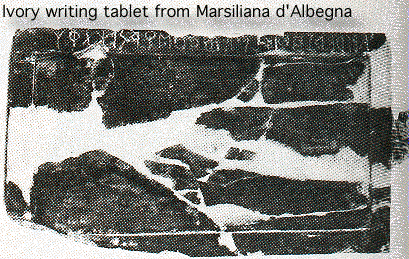
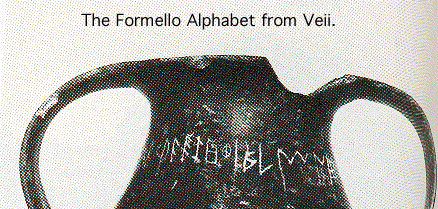
Unfortunately we cannot read the complete alphabet on this vase, but we can see enough to know that it uses the M familiar in the Vetulona Script, whereas the ivory writing tablet uses an M familiar in the Zagreb script. We'll come back to the alphabets later. Let's now visit the Tomba dei Caronti at Tarquinia.
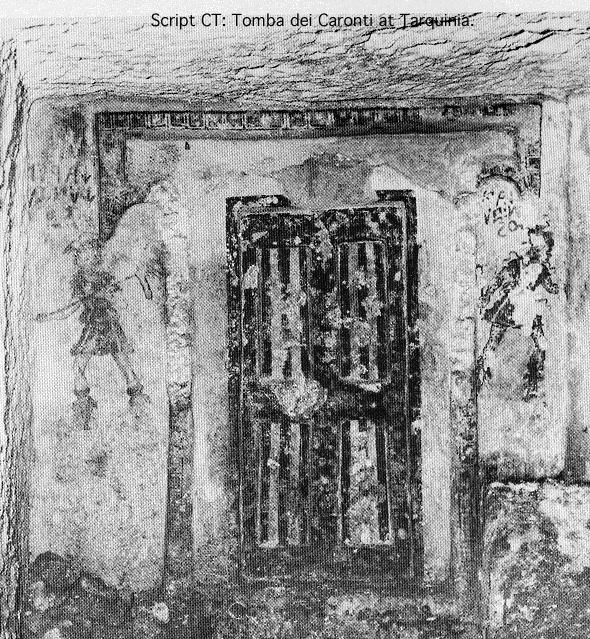
The left and right inscriptions read as follows:
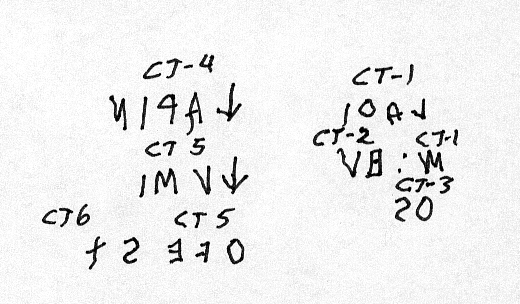
The guy holding what looks like an adze is Charin. In the Greek Hades Charon was the ferry man whom you had to pay one oble to get across the river Styx. He also was reputed to club souls over the head to assure that it's a done deal. Thus in CT4-CT 6 we have the phrase, CHARIN CHVSI RFES Te. On the right, looking at the man escaping, we have in CT1-CT3: LARIM HV OS. LAR, LARIS, LARIM is the Etruscan word for god, gods. The Etruscans did occasionally continue a word onto the next line. They didn't hyphenate. Lars and Penates were also Roman household gods. So the right hand inscription might read, "For the gods I have (the verb "to have" is similar to the Spanish and Latin, which conjugates as HA, HE, HV. It also is grouped with other verbs to show what appears to be the past perfect tense. The last word, OS, is spelled in the other scripts as VS. The Etruscan scripts rarely used the omega, "O", since the O was an R; another R was written as a P, and the D was rare. Where the D is used in a script along with the O there can be confusion, since the reader is required to determine whether the O = D, R, or O. Certain words, such as RINA, RINV,in Italian Regno, King, are always written with the O = R. The next word, CT5, appears in the other scripts. It is RFES. The F, as in FAR, is a consonant beginning a word; otherwise it is used as a vowel, often being a suffix. Since the V = O, the F = u. I read RFES as the Latin verb Ruo, ruere, "to be ruined". The Etruscan phrases often spelled TE as T. The word for "you" in Etruscan declines as TA, TE, TV, rarely TI, and TVIS, TVIM. Also there appears to be VI. At the end of a phrase it is used with an interpolated vowel (the reader must insert it) as Te. Where lower case letters are seen a vowel must be inserted. As in Hebrew the reader would know the word and the appropriate vowel.
The character CH is ofen swapped for the K in the Etruscan
scripts. In the Zagreb Mummy script it seems to refer to a CH
sound more than a K sound. So sometimes it is hard to tell. Check
out KI, KIS, and KI, KIS. Also serving
the K sound is the C, where we have CE, Ce, CEI, CIA, etc. A frequent
verb in the Etruscan scripts is CVSV, CVSE, CVSI etc. I think
CVSI is indicated at CT5. The letter
which is S appears consistently as an S in all the scripts. The
word may refer to the Latin verb, Curo, which among other things
means "to manage or to collect, procure money", which
is what it appears he is doing. The word could also relate to
the Latin verb, curo, curare, "to run hither and thither".
By the way, there are two other S's which are: S and .
For now let's assume that the phrase relating to Charin means
that Charin is hurrying and he brings you to ruin. The answer
from the fleeing soul seems to say, "By the gods I have OS.
The noun carne is often used in the texts along with os. Os in
Latin means "bone". Since the Etruscan urns carried
the same word and we know the urns contained the ashes of the
departed, the term, os, may have a broader meaning, relating to
carne, the flesh. The Etruscans believed in life after death,
so the term, os, must refer to that the soul still has its body.
In the Biblical book of Ezekiel we see a similar precept, where
Ezekiel saw the bones of people being raised up (resurrected).
At this point of our learning process, let's assume that the words and the meaning associated with them are fairly close.
The next thing we should perhaps look at is the Bilingual inscription from Pesaro, which is not, incidentally, bilingual.
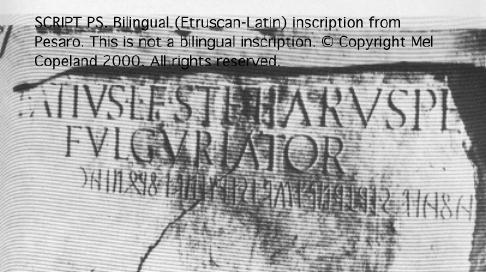

Inscription from Pesaro of L. F. Matius, Fulguriator, an augur who interpreted lightening bolts
Latin inscription (top) Matius L. F. you stood (L. sto, stare, steti, statum) the prophet/seer (L. haruspex-spicis, m.) the priest who interpreted omens from lightening (L. fulgurator-oris, m.)
Script AP-1 – A8A TESIRI
RiNI
Te
SFIS
TRYINFI
8eRVNIA Ce [Translation: to grandmother (L. avia-ae, f.; It. ava. f.) I compose/build (L. texo, texere, textum); wrath (L. ira-ae, f.) he reigned over (L. regno-are) of you (L. te; It. te); you join together (L. suo, suere, sui, sutum); of the Tyrrhini or Troinui; of 8eRVNIA Ce; of Verona here (Fr. ici). The combination of characters, 8eRV NIA, only occur in this script. I favor the latter, the name Veronia, since "ia" is a common (masculine) suffix of proper names. The suffix, "ie," is associated with feminine names.
The omega like sign is rare in the Etruscan scripts. In the scripts phrases often end with the word Ce. The word, TvRVINFI a word which refers to the name, Tyrrhenoi, is what the Greeks and Romans called the Etruscans. Several declensions of the name appear in the Etruscan Phrases.html. The Etruscans called themselves RASNA (or RASaNA), which name appears several times in the scripts. Often the scribes will spell the same word with and without the interpolated vowel in identical phrases. The word, LeTV, LETV, is one example out of several.
AVA, which appears in the Etruscan phrases, AVA, AVE, could refer to Latin Aveo, "to hail, say farewell", as in ave Maria.
The next place to visit on this page is the so called Tomba ANINA: It carries three inscriptions which are for three different ossis. We can see in the script carrying AN37-AN59 that an inscription is written over a previous inscription. Actually, the two last inscriptions were written over previous inscriptions. AN56-AN59 appear to belong to someone else. It was a family tomb and had limited space. The three texts carry similar phrases (as is usual in Etruscan scripts; there is much repetition). They begin with familiar Etruscan words: ANI and NAS, Nas referring to the word "born". It occurs frequently in the texts in particular where a list of begats of kings and queens, gods, etc. appears, relating to their place or family of origin. In this script we see a familiar family name, of Cato. Cato was a name which appeared among the Romans and one particular Cato influenced Cicero. Cicero, by the way, claimed to have been of Etruscan lineage, and the Romans treated the Etruscan blood line as being blue bloods. We still have admiration for the products of Florence,the old center of world culture. So let's look at the best and no doubt latest painting on the tomb's walls:
![]()

Compare this to the earlier inscriptions (which are hard to read):

The following is my transcription of the above:
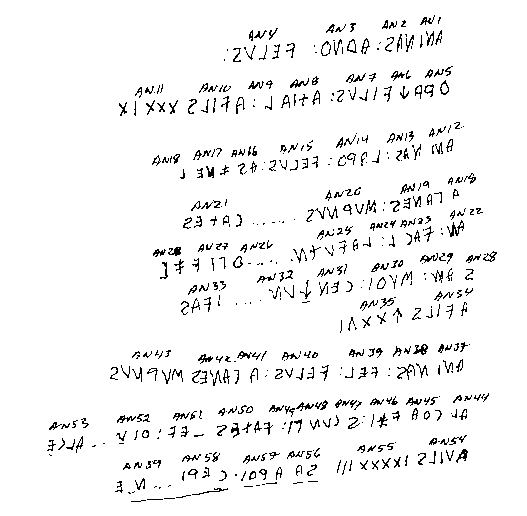
The scripts read as follows:
AN1--ANI NAS: ARNO: FELVS:
AN5--ORA Ki FILVS: ATIA Le: AFILeS XXXIX
AN12--ANI NAS: LARO: FELVS: AS SeNE LA PENAS: SVRvNVS......damaged text........CATES
AN22--AN: FAC Le: LA FVTeN......R PI FeSIS
AN28--AMe: SVRI: CENe CHVN......damaged text.....IFAS
AN34--AFILeS LXXVI; Note The "arrow" symbol in the numbers may be "50" ; in other scripts we see time measured with LXX and sometimes the L is upside down.
AN37--ANI NAS: FEL: FELVS: A PANES SVRvNVS
AN44--AL CaRA FiSI: Sa CVNe PI: FATES _EF: RIV....damaged text.....ALCE
AN54--AVILeS IXXXXIII SA AROICERI......N..E
Let's begin with the last word of these scripts. AVILeS is a common term in the Etruscan scripts. I read the Latin word, habiles, "to have, posses," etc. This is not to be confused with the word, AVLE, AFLE, aule, a term which refers to the title of lord, or prince, as in Latin. The letter, "B" is rare in the Etruscan scripts and seems to be replaced with 8, F, and V, but we shall sort this out as we proceed. Words here which are common to the Etruscan Phrases html are: ANI, NAS, FEL, FELVS, ORA, KI, Ki, FILVS, ATI, ATIA, AN, FACa, LA, AMe, AMA, AMaPA, AMEM, AMAR, AMOVR, SVRI, CENe, CENA,CENI, CENV, CaRA, CARE, CARV, CVNe, CVNA, CVNES, FATE, FATES, ARA, ARE, ARV, ARO, AROI, CERI. PANES SVRvNVS appears to be a place name; however the word for sister, SVR, and NVS (our) also appear in the Etruscan Phrases. The word, PAN, appears in the Etruscan scripts. FEL often precedes a name or title. ATI refers to the Etruscan patriarch in Lydia, ATIS. FACa is a frequent verb, probably fare, to make, to do. Like this verb there is 8ARa. Ati Gerius is a common appelation in the Tavola Eugubine, scripts N, Q, R and G. The ephitet is spelled: ATIIERIA.
Since we are drafting a learning process, let's go on to another interesting text, which is short and sweet and is on a mirror which shows Hercules suckling from the goddess VNI (Uni). VNI is a frequent name in the Etruscan Phrases texts. We know it is Hercules depicted in the mirror because he carries a club, which is his sign. Compare this with the Divine Mirror.html which shows Hercules presenting a child with wings named, EPE VR (Epe Or) to the supreme god, TINIA, also called TIN, TINI. VR is a major name in the Etruscan Phrases html. Vni is not the wife of TINIA according to the Divine Mirror. TINIA, who is Zeus, is married to a goddess whose sign is a goose. In the Divine Mirror we see RALNA seated to the left of TINIA and beside her is a goose. The seduction of a goddess by Zeus involved the metamorphosis of Zeus and the goddess into a swan and a goose. This is mirror which shows Hercules suckling at the breast of Vni:
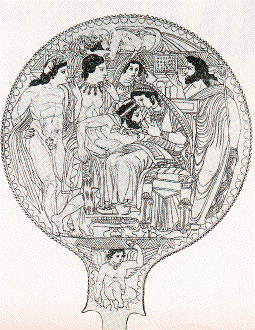
The script which tells the story:
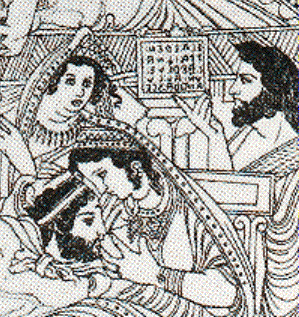
My Transcription:
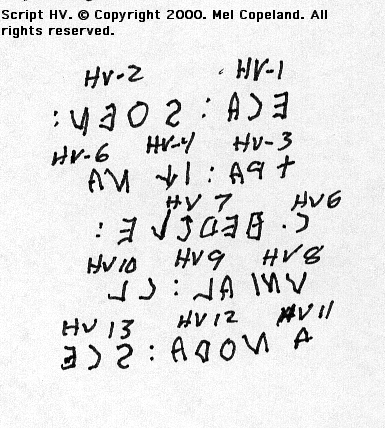
HV1--ECA: SaREN:
HV3--TaRA: IK NAC
HV7--HERCLE:
HV8--VNI AL: CaLa
HV11--A NORA: SeCE
All of these words are familiar to the Etruscan Phrases html. ECA, ECE, SaRENe, or SeRENE, TARA, TaRA, TARAS, HERCvLE, VNI, AL, CaLa, A, NORA and SeCE.
![]() Return me to Etruscan_Phrases.html
Return me to Etruscan_Phrases.html
launched 1.09.200
1.09.2000; 2.12.06
Copyright © 2000-2006 Maravot. All rights reserved. Publication of the information in this site in any media without the prior written consent of the author is forbidden.